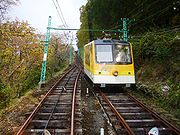
Myoken Cable
Encyclopedia

Japan
Japan is an island nation in East Asia. Located in the Pacific Ocean, it lies to the east of the Sea of Japan, China, North Korea, South Korea and Russia, stretching from the Sea of Okhotsk in the north to the East China Sea and Taiwan in the south...
ese funicular
Funicular
A funicular, also known as an inclined plane or cliff railway, is a cable railway in which a cable attached to a pair of tram-like vehicles on rails moves them up and down a steep slope; the ascending and descending vehicles counterbalance each other.-Operation:The basic principle of funicular...
line in Kawanishi
Kawanishi, Hyogo
is a city located in Hyōgo Prefecture in the northwestern part of the Kansai Region of Japan, about 5 km north of Osaka Itami Airport. It is bordered on the west by Inagawa River.-History:...
, Hyōgo
Hyogo Prefecture
is a prefecture of Japan located in the Kansai region on Honshū island. The capital is Kobe.The prefecture's name was previously alternately spelled as Hiogo.- History :...
, operated by Nose Electric Railway. The line climbs . The line was opened by in 1925, comprising Kabu Line and Jōbu Line. Both of them were abandoned in 1944. Kabu Line reopened in 1960 as Myōken Cable, while Jōbu Line became a chairlift
Chairlift
An elevated passenger ropeway, or chairlift, is a type of aerial lift, which consists of a continuously circulating steel cable loop strung between two end terminals and usually over intermediate towers, carrying a series of chairs...
.
Basic data
- Distance: 0.6 kilometre (0.372823641989884 mi)
- GaugeRail gaugeTrack gauge or rail gauge is the distance between the inner sides of the heads of the two load bearing rails that make up a single railway line. Sixty percent of the world's railways use a standard gauge of . Wider gauges are called broad gauge; smaller gauges, narrow gauge. Break-of-gauge refers...
: (Standard gauge, in contrast to the narrow gauge of most Japanese railways including funiculars.) - Stations: 2
- Vertical interval: 229 m (751.3 ft)
Stations
| Station | Connection | Location | |
|---|---|---|---|
| Myōken Cable | |||
| Kurokawa Kurokawa Station (Hyōgo) is a funicular station in Kawanishi, Hyōgo Prefecture, Japan.-Adjacent stations:... 黒川 |
|
Kawanishi | Hyōgo Prefecture |
| Cable Sanjō Cable Sanjō Station is a funicular station in Kawanishi, Hyōgo Prefecture, Japan.-Adjacent stations:... ケーブル山上 |
|
||
| Myōken Lift | |||
| Myōken-no-mizu Hiroba-mae Myōken-no-mizu Hiroba-mae Station is an aerial tramway station in Kawanishi, Hyōgo Prefecture, Japan.-Adjacent stations:... 妙見の水広場前 |
|
Kawanishi | Hyōgo Prefecture |
| Myōkensan Myōkensan Station is an aerial tramway station in Kawanishi, Hyōgo Prefecture, Japan.-Adjacent stations:... 妙見山 |
|||

